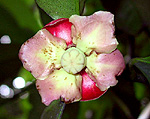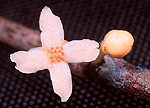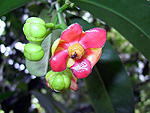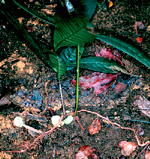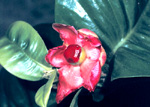 |
QUICK SEARCH
MO PROJECTS:
Africa
Asia/Pacific
Mesoamerica
North America
South America
General Taxonomy
Photo Essays
Training in Latin
America
MO RESEARCH:
Wm. L. Brown Center
Bryology
GIS
Graduate Studies
Research Experiences
for Undergraduates
Imaging Lab
Library
MBG Press
Publications
Climate Change
Catalog Fossil Plants
MO DATABASES:
W³MOST
Image Index
Rare Books
Angiosperm
Phylogeny
Res Botanica
All Databases
INFORMATION:
What's New?
People at MO
Visitor's Guide
Herbarium
Jobs & Fellowships
Symposium
Research Links
Site Map
Search
Mangosteen MadnessWritten by: Patrick SweeneyPh.D. candidate, University of Missouri, St. Louis, MO |
||||
|
While inching along in a traffic jam outside of Kuala Lumpur, a sprawling city of 1.5 million and the capital of Malaysia, pristine rainforest and the plants I was seeking seemed like a million miles away. Peninsular Malaysia is approximately 132,000 square kilometers in area and over 50% is covered in various types of forest. Much of the forest habitat is confined to higher elevations along the main western mountain range and to mountainous areas in the east. While a large amount of the forest in lowland areas has been logged and converted to agriculture - much in the form of oil palm (Elaeis guineensis) plantations - lowland rainforest is still abundant and some of it quite close to the populous capital. After traveling just over two hours from this vehicular snarl, I was in the Sungai Lallang Forest Reserve and immersed in Lowland Dipterocarp Rainforest. My reason for visiting this forest and Southeast Asia in general was to search for representatives of Garcinia, a genus in the Clusiaceae (St. Johnís-wort family) I am studying for my PhD dissertation research at the University of Missouri, St. Louis. |
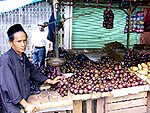 Mangosteen (Garcinia mangostana) |
|||
Garcinia consists of roughly 300 species of dioecious trees and shrubs distributed into South America (where they are also known as Rheedia), Africa, Madagascar, and Southeast Asia. Most of the species diversity in the genus is centered in Malesia, with over two-thirds of the species in the genus being found there. Among the most well-known and economically important species is mangosteen (G. mangostana) [see picture] a widely consumed fruit in Southeast Asia that is considered the "Queen of Fruits" because of its superior gustatory qualities. However, other species are gaining in economic importance, especially for their purported pharmacological utility. For example, extracts of G. cambogia are widely available for anti-obesity purposes. Garcinia is of systematic and evolutionary interest for several reasons. At an alpha-taxonomic level much work remains to be done. For example, 10 of the 49 species recognized by T. C. Whitmore as occurring in peninsular Malaysia were not given specific designations in his treatment of the group for the Tree Flora of Malaya. He resisted naming these species out of concern that they may have been named elsewhere in Malesia. From an evolutionary perspective, Garcinia presents an interesting subject for the study of floral evolution, with the male flowers in particular being incredibly diverse. Examples are: G. macrophylla (male) [see picture] growing at the Bogor Botanic Garden; G. parvifolia (male) [see picture] growing in Singapore; G. atroviridis (male) [see picture] growing in Malaysia. The focus of my PhD research is to investigate this floral diversity within the context of a molecular phylogeny and to begin to characterize morphological and developmental differences between these diverse flower types. |
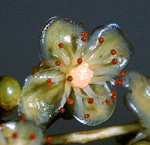 Garcinia macrophylla |
|||
|
Along with several species of Garcinia, Sungai Lallang Forest Reserve is home to a few peninsular Malaysian endemics, including a palm, Johannesteijsmannia magnifica [see picture], that my collaborators and I from the Forest Research Institute of Malaysia (FRIM) observed during our explorations . Other areas of Lowland Dipterocarp Rainforest that I visited in Malaysia included Semenyih Forest Reserve and Pasoh Forest Reserve. The latter is known for its well-studied 50-ha research plot where over 300,000 individuals representing more than 800 species were recorded in a census of all woody stems in the plot above 1 cm in diameter. Of the 20 taxa in the plot unknown to species, four are Garcinia and probably represent taxa not previously recorded for peninsular Malaysia, or they represent new species, illustrating the poor state of alpha-level taxonomy within Garcinia and highlighting the need for more work within group. |
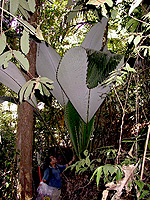 Johannesteijsmannia magnifica |
|||
Other areas in Malaysia that I frequented included montane rainforest. Many rare, endemic species of Garcinia on the peninsula are confined to one or a few mountain peaks scattered along the main range or in the eastern part of the peninsula. Garcinia cantleyana var. grandifolia, for example, has only been collected on the top of Gunung Ulu Kali and was last collected in the mid-1980's. Alarmingly, Gunung Ulu Kali is in Genting Highlands, an area famous in Malaysia for its casinos and amusement parks, and is a mere stones throw away from large multistory vacation condominiums. Nevertheless, G. Ulu Kali has remained forested [see picture of Nepenthes in the forest] and I was able to locate several individuals of G. cantleyana var. grandifolia [see picture] some of which were reproductive. While working in the area we observed a siamang (Hylobates syndactylus), a rare gibbon endemic to peninsular Malaysia and Sumatra. |
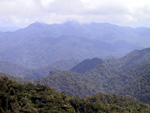 Genting Highlands
Genting Highlands |
|||
|
I also had the opportunity to visit Singapore and Indonesia where I worked largely in botanical gardens and herbaria. In Singapore the majority of my time was spent working in the Singapore Botanic Garden herbarium, viewing and photographing type specimens. Incidentally, it was a former director of the Singapore Botanical Garden, Henry Ridley, who was instrumental in the introduction of Para Rubber (Hevea brasiliensis) into Southeast Asia as an important economic crop. Most of the Garcinia planted in the garden are native to Singapore or peninsular Malaysia; however, from the garden nursery I was able acquire a few plants found only in the eastern part of Southeast Asia. While Singapore is essentially a small island crammed with 5 million people, there are some areas of forest left. I visited two such areas, Bukit Timah Forest Reserve and MacRitchie Reservoir Forest, to search for Garcinia, and was successful in finding seven of the nine species native to Singapore. Unfortunately the uncollected species were recorded on the island many decades ago and have not been collected since. In MacRitchie Reservoir Forest, I observed G. griffithii [see picture] reproducing vegetatively via root suckers, a reproductive strategy that seems to be uncommon in tropical trees. During my travels, I observed this phenomenon in three other Garcinia species. |
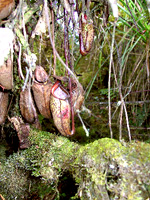 Nepenthes (East Indian pitcher-plants) in forests near Gunung Ulu Kali [see image from Tropicos database] |
|||
|
After Singapore, I flew to Jakarta, which is situated on the island of Java and is the capital of Indonesia. From there I proceeded directly to the city of Bogor in order to visit the Bogor Botanic Garden, originally in established 1817 as the Buitenzorg Botanic Garden. During its long history many notable individuals have been associated with the garden including Melanchoir Treub, one of the first to elucidate the developmental history of Lycopods, and Sir Stamford Raffles, the founder of Singapore and an important figure in Southeast Asian history. Also during its history the garden has managed to acquire over 30 species of Garcinia from all over the world; hence, my desire to visit this garden. It was here that I was able to collect 20 species that I encountered nowhere else during my travels. Some of my time was devoted to examining and photographing specimens in Herbarium Bogoriense. This herbarium is the largest and one of the most important in Southeast Asia. Before I departed Indonesia, I visited Taman Buah Mekarsari, a very ambitious agro-tourism and research park near Jakarta that was founded and managed by one of former Prime Minister Soeharto's daughters. The park is a 264 ha facility comprised of large orchards that are filled with representatives of virtually every fruit tree species grown in Southeast Asia. I was given a fabulous tour of this facility by Gregory Hambali and Reza Tirtawinata where I saw an 8-inch high fruiting mangosteen and gorged on rambutan (Nephelium lappaceum) [see picture]. |
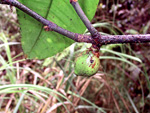 Garcinia cantleyana var. grandifolia |
|||
|
Overall, my trip was very successful. The materials I collected will provide the means for me to begin elucidating higher-level relationships among species of Garcinia; the central part of my PhD dissertation research. I was able to make 161 herbarium collections representing over 50 species. I have DNA material for 96 of these specimens and pickled material for about 120. |
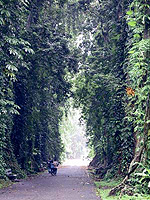 Bogor Botanic Garden |
|||
|
Before I conclude I must thank the numerous individuals who made this trip a success. My trip would not have been possible at all without funding provided by the Jane and Whitney Harris scholarship (administered by ICTE) and the Missouri Botanical Garden. The trip would not have been nearly as productive without the help of several institutions and collaborators in the region. In Malaysia, I was heavily dependent on the Forest Research Institute (FRIM), which provided all of my logistical support at a highly subsidized, struggling graduate student rate. At FRIM, Dr. Richard Chung and Dr. Saw Leng-Guan, the director of the FRIM herbarium, were particularly helpful in sorting out logistical details and in helping arrange much of my fieldwork. In Singapore, Dr. Ruth Kiew, the director of the Singapore Botanic Garden Herbarium, and Dr. Jaap Jan Vermeulen, a curator at the herbarium, were very gracious hosts. Finally, in Indonesia the folks at the Indonesian Institute of Sciences (LIPI) were a tremendous help, especially Rismita Sari, who arranged for my invitation to the Bogor Botanic Garden and who provided for many stimulating discussions about Garcinia. Deby Arifiani was a big help in arranging for my entry into Herbarium Bogoriense. Finally, I must give thanks to the various field assistants I relied on throughout the trip in particular Busa Baya, Samsuri Ahmad, Kamrudin Salleh, and Mat Asri Ngah Samah. These individuals had a wealth of knowledge and were very good at spotting Garcinia. |
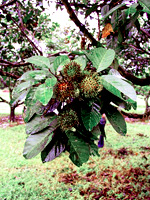 Rambutan [Nephelium lappaceum] |
|||
|
||||
© 1995-2025 Missouri Botanical Garden, All Rights Reserved
4344 Shaw Blvd.
St. Louis, MO 63110
(314) 577-5100
Technical Support
